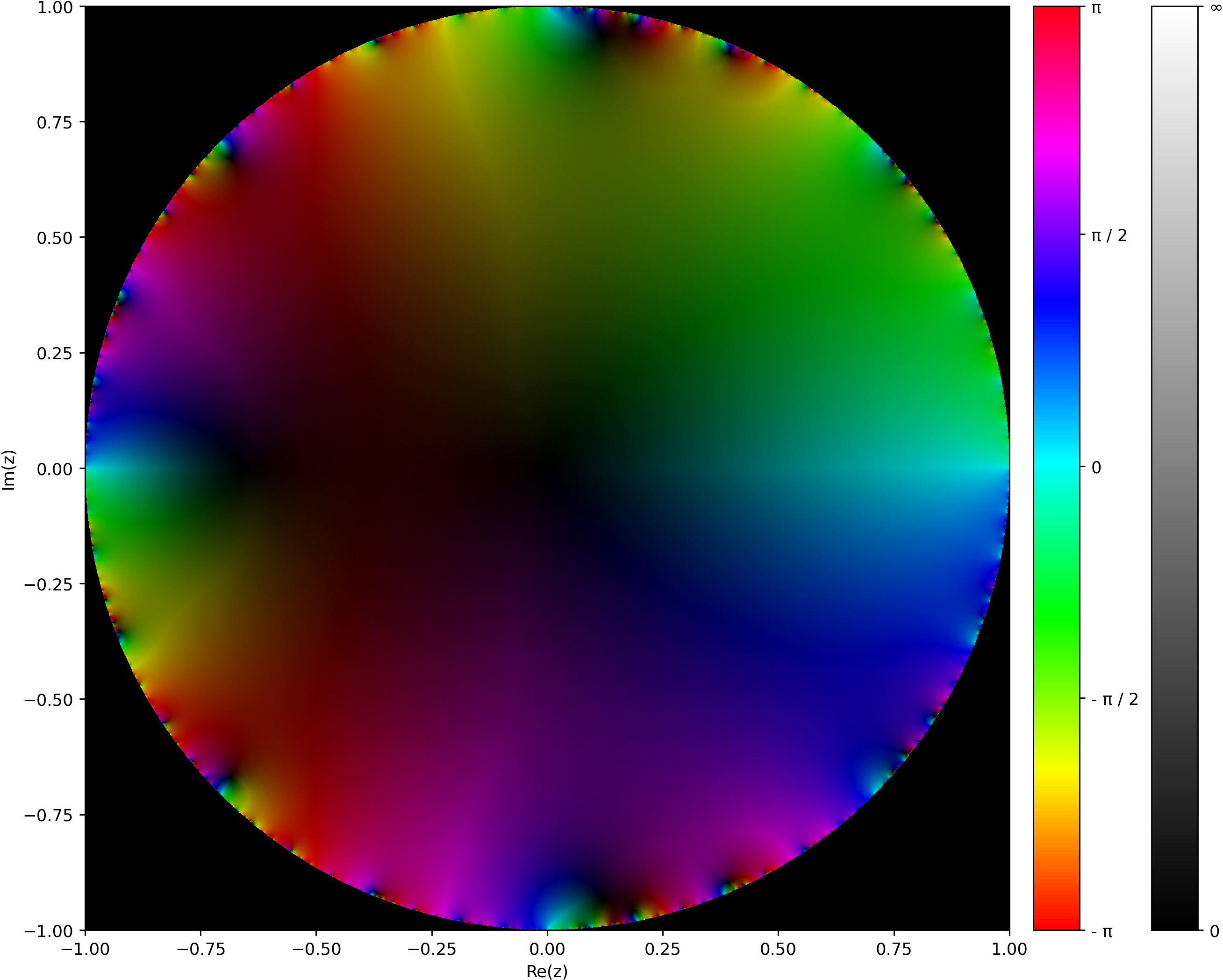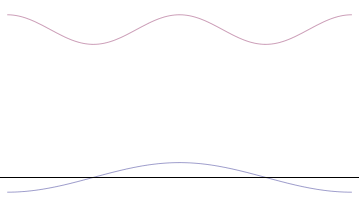|
Chebotarev Theorem On Roots Of Unity
The Chebotarev theorem on roots of unity was originally a conjecture made by Ostrowski in the context of lacunary series. Chebotarev was the first to prove it, in the 1930s. This proof involves tools from Galois theory and pleased Ostrowski, who made comments arguing that it "''does meet the requirements of mathematical esthetics''". Several proofs have been proposed since, and it has even been discovered independently by Dieudonné. Statement Let \Omega be a matrix with entries a_ =\omega^,1\leq i,j\leq n , where \omega =e^,n\in \mathbb. If n is prime then any minor of \Omega is non-zero. Equivalently, all submatrices of a DFT matrix of prime length are invertible. Applications In signal processing, the theorem was used by T. Tao to extend the uncertainty principle The uncertainty principle, also known as Heisenberg's indeterminacy principle, is a fundamental concept in quantum mechanics. It states that there is a limit to the precision with which certa ... [...More Info...] [...Related Items...] OR: [Wikipedia] [Google] [Baidu] |
Alexander Ostrowski
Alexander Markowich Ostrowski (; ; 25 September 1893 – 20 November 1986) was a mathematician. Biography His father Mark having been a merchant, Alexander Ostrowski attended the Kiev College of Commerce, not a high school, and thus had an insufficient qualification to be admitted to university. However, his talent did not remain undetected: Ostrowski's mentor, Dmitry Grave, wrote to Edmund Landau and Kurt Hensel for help. Subsequently, Ostrowski began to study mathematics at Marburg University under Hensel's supervision in 1912. During World War I he was interned, but thanks to the intervention of Hensel, the restrictions on his movements were eased somewhat, and he was allowed to use the university library. After the war ended, Ostrowski moved to Göttingen where he wrote his doctoral dissertation and was influenced by David Hilbert, Felix Klein, and Landau. In 1920, after having obtained his doctorate from the University of Göttingen, Ostrowski moved to Hamburg where he ... [...More Info...] [...Related Items...] OR: [Wikipedia] [Google] [Baidu] |
Lacunary Function
In analysis, a lacunary function, also known as a lacunary series, is an analytic function that cannot be analytically continued anywhere outside the radius of convergence within which it is defined by a power series. The word ''lacunary'' is derived from lacuna (''pl.'' lacunae), meaning gap, or vacancy. The first known examples of lacunary functions involved Taylor series with large gaps, or lacunae, between the non-zero coefficients of their expansions. More recent investigations have also focused attention on Fourier series with similar gaps between non-zero coefficients. There is a slight ambiguity in the modern usage of the term lacunary series, which may refer to either Taylor series or Fourier series. A simple example Pick an integer a \geq 2. Consider the following function defined by a simple power series: : f(z) = \sum_^\infty z^ = z + z^a + z^ + z^ + z^ + \cdots\, The power series converges locally uniform on any open domain , ''z'', 0 is an arbitrary positive ... [...More Info...] [...Related Items...] OR: [Wikipedia] [Google] [Baidu] |
Nikolai Chebotaryov
Nikolai Grigorievich Chebotaryov (often spelled Chebotarov or Chebotarev; ; ; – 2 July 1947) was a Soviet mathematician. He is best known for the Chebotaryov density theorem. He was a student of Dmitry Grave. Chebotaryov worked on the algebra of polynomials, in particular examining the distribution of the zeros. He also studied Galois theory and wrote a textbook on the subject titled ''Basic Galois Theory''. His ideas were used by Emil Artin to prove the Artin reciprocity law. He worked with his student Anatoly Dorodnov on a generalization of the quadrature of the lune, and proved the conjecture now known as the Chebotarev theorem on roots of unity. Early life Nikolai Chebotaryov was born on 15 June 1894 in Kamianets-Podilskyi, Russian Empire (now in Ukraine). He entered the department of physics and mathematics at Kiev University in 1912. In 1928, he became a professor at Kazan University Kazan Federal University (; ) is a public research university located in Kazan, Russ ... [...More Info...] [...Related Items...] OR: [Wikipedia] [Google] [Baidu] |
Galois Extension
In mathematics, a Galois extension is an algebraic field extension ''E''/''F'' that is normal and separable; or equivalently, ''E''/''F'' is algebraic, and the field fixed by the automorphism group Aut(''E''/''F'') is precisely the base field ''F''. The significance of being a Galois extension is that the extension has a Galois group and obeys the fundamental theorem of Galois theory. A result of Emil Artin allows one to construct Galois extensions as follows: If ''E'' is a given field, and ''G'' is a finite group of automorphisms of ''E'' with fixed field ''F'', then ''E''/''F'' is a Galois extension. The property of an extension being Galois behaves well with respect to field composition and intersection. Characterization of Galois extensions An important theorem of Emil Artin states that for a finite extension E/F, each of the following statements is equivalent to the statement that E/F is Galois: *E/F is a normal extension and a separable extension. *E is a splitting ... [...More Info...] [...Related Items...] OR: [Wikipedia] [Google] [Baidu] |
Jean Dieudonné
Jean Alexandre Eugène Dieudonné (; 1 July 1906 – 29 November 1992) was a French mathematician, notable for research in abstract algebra, algebraic geometry, and functional analysis, for close involvement with the Nicolas Bourbaki pseudonymous group and the ''Éléments de géométrie algébrique'' project of Alexander Grothendieck, and as a historian of mathematics, particularly in the fields of functional analysis and algebraic topology. His work on the classical groups (the book ''La Géométrie des groupes classiques'' was published in 1955), and on formal groups, introducing what now are called Dieudonné modules, had a major effect on those fields. He was born and brought up in Lille, with a formative stay in England where he was introduced to algebra. In 1924 he was admitted to the École Normale Supérieure, where André Weil was a classmate. He began working in complex analysis. In 1934 he was one of the group of ''normaliens'' convened by Weil, which would become ' B ... [...More Info...] [...Related Items...] OR: [Wikipedia] [Google] [Baidu] |
Submatrix
In mathematics, a matrix (: matrices) is a rectangular array or table of numbers, symbols, or expressions, with elements or entries arranged in rows and columns, which is used to represent a mathematical object or property of such an object. For example, \begin1 & 9 & -13 \\20 & 5 & -6 \end is a matrix with two rows and three columns. This is often referred to as a "two-by-three matrix", a " matrix", or a matrix of dimension . Matrices are commonly used in linear algebra, where they represent linear maps. In geometry, matrices are widely used for specifying and representing geometric transformations (for example rotations) and coordinate changes. In numerical analysis, many computational problems are solved by reducing them to a matrix computation, and this often involves computing with matrices of huge dimensions. Matrices are used in most areas of mathematics and scientific fields, either directly, or through their use in geometry and numerical analysis. '' Square matr ... [...More Info...] [...Related Items...] OR: [Wikipedia] [Google] [Baidu] |
DFT Matrix
In applied mathematics, a DFT matrix is a ''square matrix'' as an expression of a discrete Fourier transform (DFT) as a transformation matrix, which can be applied to a signal through matrix multiplication. Definition An ''N''-point DFT is expressed as the multiplication X = W x, where x is the original input signal, W is the ''N''-by-''N'' square matrix, square DFT matrix, and X is the DFT of the signal. The square matrix ensures the transformation is invertable. The transformation matrix W can be defined as W = \left(\frac\right)_ , or equivalently: : W = \frac \begin 1&1&1&1&\cdots &1 \\ 1&\omega&\omega^2&\omega^3&\cdots&\omega^ \\ 1&\omega^2&\omega^4&\omega^6&\cdots&\omega^\\ 1&\omega^3&\omega^6&\omega^9&\cdots&\omega^\\ \vdots&\vdots&\vdots&\vdots&\ddots&\vdots\\ 1&\omega^&\omega^&\omega^&\cdots&\omega^ \end , where \omega = e^ is a Root of unity, primitive ''N''th root of unity in which i^2=-1. We can avoid writing large exponents for \omega using the fact that for any exp ... [...More Info...] [...Related Items...] OR: [Wikipedia] [Google] [Baidu] |
Signal Processing
Signal processing is an electrical engineering subfield that focuses on analyzing, modifying and synthesizing ''signals'', such as audio signal processing, sound, image processing, images, Scalar potential, potential fields, Seismic tomography, seismic signals, Altimeter, altimetry processing, and scientific measurements. Signal processing techniques are used to optimize transmissions, Data storage, digital storage efficiency, correcting distorted signals, improve subjective video quality, and to detect or pinpoint components of interest in a measured signal. History According to Alan V. Oppenheim and Ronald W. Schafer, the principles of signal processing can be found in the classical numerical analysis techniques of the 17th century. They further state that the digital refinement of these techniques can be found in the digital control systems of the 1940s and 1950s. In 1948, Claude Shannon wrote the influential paper "A Mathematical Theory of Communication" which was publis ... [...More Info...] [...Related Items...] OR: [Wikipedia] [Google] [Baidu] |
Terence Tao
Terence Chi-Shen Tao (; born 17 July 1975) is an Australian-American mathematician, Fields medalist, and professor of mathematics at the University of California, Los Angeles (UCLA), where he holds the James and Carol Collins Chair in the College of Letters and Sciences. His research includes topics in harmonic analysis, partial differential equations, algebraic combinatorics, arithmetic combinatorics, geometric combinatorics, probability theory, compressed sensing and analytic number theory. Tao was born to Chinese immigrant parents and raised in Adelaide. Tao won the Fields Medal in 2006 and won the Royal Medal and Breakthrough Prize in Mathematics in 2014, and is a 2006 MacArthur Fellow. Tao has been the author or co-author of over three hundred research papers, and is widely regarded as one of the greatest living mathematicians. Life and career Family Tao's parents are first generation immigrants from Hong Kong to Australia.'' Wen Wei Po'', Page A4, 24 August ... [...More Info...] [...Related Items...] OR: [Wikipedia] [Google] [Baidu] |
Uncertainty Principle
The uncertainty principle, also known as Heisenberg's indeterminacy principle, is a fundamental concept in quantum mechanics. It states that there is a limit to the precision with which certain pairs of physical properties, such as position and momentum, can be simultaneously known. In other words, the more accurately one property is measured, the less accurately the other property can be known. More formally, the uncertainty principle is any of a variety of mathematical inequalities asserting a fundamental limit to the product of the accuracy of certain related pairs of measurements on a quantum system, such as position, ''x'', and momentum, ''p''. Such paired-variables are known as complementary variables or canonically conjugate variables. First introduced in 1927 by German physicist Werner Heisenberg, the formal inequality relating the standard deviation of position ''σx'' and the standard deviation of momentum ''σp'' was derived by Earle Hesse Kennard later that ... [...More Info...] [...Related Items...] OR: [Wikipedia] [Google] [Baidu] |
Theorems In Linear Algebra
In mathematics and formal logic, a theorem is a statement that has been proven, or can be proven. The ''proof'' of a theorem is a logical argument that uses the inference rules of a deductive system to establish that the theorem is a logical consequence of the axioms and previously proved theorems. In mainstream mathematics, the axioms and the inference rules are commonly left implicit, and, in this case, they are almost always those of Zermelo–Fraenkel set theory with the axiom of choice (ZFC), or of a less powerful theory, such as Peano arithmetic. Generally, an assertion that is explicitly called a theorem is a proved result that is not an immediate consequence of other known theorems. Moreover, many authors qualify as ''theorems'' only the most important results, and use the terms ''lemma'', ''proposition'' and ''corollary'' for less important theorems. In mathematical logic, the concepts of theorems and proofs have been formalized in order to allow mathematical reason ... [...More Info...] [...Related Items...] OR: [Wikipedia] [Google] [Baidu] |




